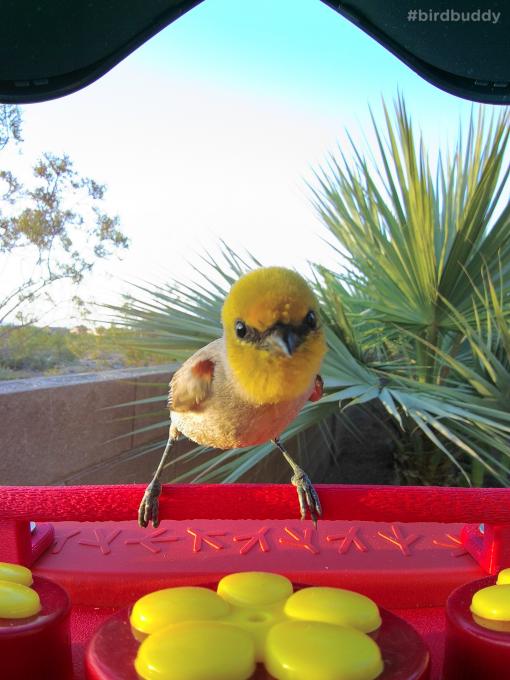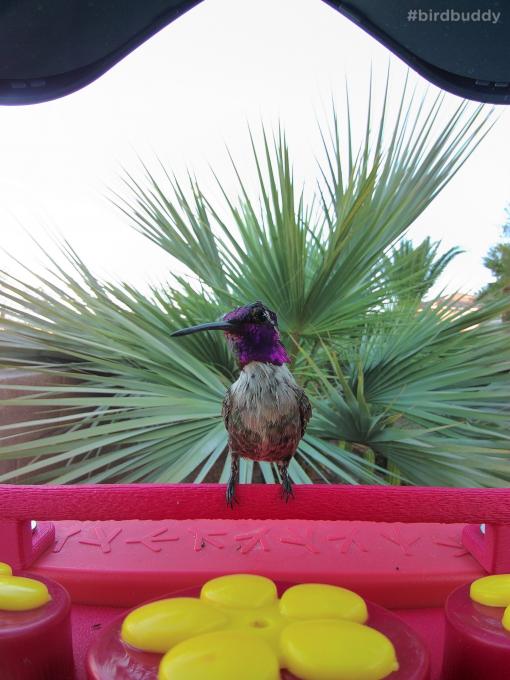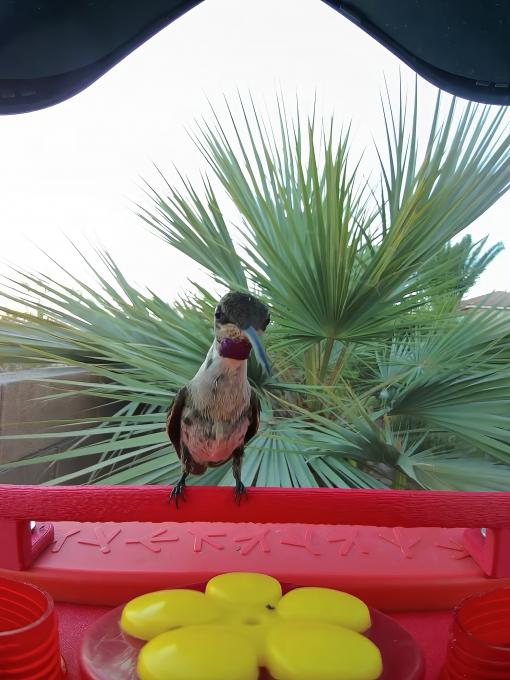The Cornell Lab Bird Academy › Discussion Groups › The Wonderful World of Hummingbirds › Life of a Hummingbird
-
I was surprised to find that hummingbirds have way more similarities than differences, when compared with other birds in my backyard. One big difference I find is the way they feed of nectar. I found that fascinating.
-
The aerodynamics of their flying is fascinating to me. They are able to maneuver in ways that other birds can't.
-
There don't seem to be any significant differences from other birds that various other birds also have with each other. The many variations within Aves showcase just how well birds have evolved the variously take care of their various needs.
-
While they have to do all of the basic things that other birds do (find food, rest, communicate, find mates, build nests, raise young, and possibly migrate), the ways that hummingbirds manage to do this are fascinating and often show special adaptations based on their small size and high energy needs. The expanding spider's-silk nests in particular are delightful - a perfect means of protecting chicks that undergo tremendous growth from hatching to fledging.
-
The similarities between the hummingbirds and the other birds are the courtship, nesting and birthing their young. I believe the locations for nesting are different between the hummingbirds and other birds, as well as the communicational sounds. Hummingbirds have a softer sound. What beautiful birds. Ruth
-
Much like the Ruby-Throated Hummingbird, the Canada Goose (Branta canadensis) is also well known for migrating south to Mexico for the winter months, and then back to the north for the breeding season. However, their behaviors during migration are very different. Relative to their weight, Canada Geese don't need to eat as often as a hummingbird does, and the distinctive "V" formation they fly in as groups during migration reduces wind resistance for group members further down the lines. Additionally, they regularly alternate positions in the "V" while flying, allowing the birds to rest at regular intervals and distribute the effort, as the one at the front of the "V" is working the hardest. All of this combined makes it so that Canada Geese can fly for very long periods of time without stopping, whereas hummingbirds must make frequent stops to feed.
-
I was surprised to learn that the male hummingbirds do not participate at all in the nest building or raising of young. I compare them to the Gambel's Quail which live in my area where the males are very active in "family life".
-
Hummingbirds are similar to other birds in daily routine (eat, sleep, toilet), procreation requirements, and some migration. However, it seems the hummer needs to feed constantly or enter the state of Torpor at night to maintain energy levels. How are the Ruby-Throats able to cross the Gulf of Mexico during Fall Migration when they have to fly approximately 550 miles and fly about 10 hours of constant flying? It seems incredible with only 4% stored fat. Or is there something else that happens that allow the tiny hummers to make the flight over the Gulf?
-
I have a question. If I feed the hummingbird sugar water, isn't that like feeding them McDonald's. IS there some nutrient powder to give them instead?
-
I have wondered that myself.
-
I was just thinking this as I saw them drinking from the feeder. How different is our sugar water, in nutrients, from what they would get from a more natural source?
-
-
 Albuquerque, New Mexico. As a rain started, I watched and photographed a Rufous Hummingbird doing his "toilet:" preening, spreading its wings and tail. Wonderful! Celestyn
Albuquerque, New Mexico. As a rain started, I watched and photographed a Rufous Hummingbird doing his "toilet:" preening, spreading its wings and tail. Wonderful! Celestyn -
A beautiful sequence of images!
-
-
There is a difference with some birds that have the same mate along their life. According to the lesson my conclusion is hummingbirds have different mates,
-
Hummingbirds do not walk around like other bids because their feet ,legs are made only of sitting on branches etc. They build nest in more unusual places. All hummingbirds do not migrate..ex.carribean .tropical etc. They sleep in a "stasis"?(term?) like state to conserve energy/heat .The males leave once eggs are laid,only female cares for young. Similar to other birds they bath in water,groom their feathers with their beaks, mate , nest,diet includes insects ,diverse.........
-
I feel like I have a new appreciation for Female hummingbirds and all that work they do. Sure the males are flashy and do sensational acrobatics but the female hummingbirds are hard working, attentive, artistic & creative lil birds! I've watched many species with both the male and female putting in equal work nest building & raising young ( Crow families are fascinating to watch!) I had no idea that the hummingbird males did not chip in.
-
I think it is really neat that hummingbirds wrap the outside of the nests with spider webs. I wonder if any other birds build the nest to expand as the babies grow? That was really interesting. I enjoyed the pictures of the various nests and found the one on the lock to be a most interesting location. Many male birds help in nest building and feeding of the young so one difference is that hummingbird females do all the work. In the past I have noticed that both male and female Robins gather the materials, but the female is the main nest builder. Both Robin parents help feed the young. With cardinals the male seems to gather the materials while the female builds. When she is nesting the male brings her food but he does not seem to help with the eggs. They both help care for the babies once hatched. As for Eastern bluebirds the male brings the nesting materials and sits on the nest box while she works on the nest. (I guess to keep watch and protect the nest). The female builds the nest and sits on the eggs. Both bluebird parents feed the young. The male hummingbird makes a showy display to attract a mate but then does not participate in any of these activities.
-
It seems that many aspects of a hummingbird's life are similar to other species of birds - courtship, nest building, caring for young, migrating. After reading about how hummingbirds enter a state of torpor at night, I'm wondering how this works when the female is incubating eggs? Does her body trap heat close to the eggs to keep them warm while she sleeps?
-
Most of the most common (visible) birds in the southeastern US are songbirds who either do not migrate, or that do, but because they come from farther north, as well as being local, like Robins, are almost always around, whether living here, or passing through on their way both south and north. Most of such birds that live in conjunction to humans raise several clutches of chicks per breeding season, and both parents are equally involved in caring for them. It is comical to see the fledged and nearly grown chicks, often as large as their parents, trying to extend their "childhood" by badgering their parents to keep feeding them, as the parents try to "kick them out of the nest," as is often said about human parents.
-
Hummingbirds have a very intense migration, with some crossing the entire Gulf of Mexico in a day of flight. I can't think of any other birds that migrate so far compared with their body length, when you put into perspective how small they are and how far they fly, the Hummingbird is truly an amazing set of birds! In my area, Anna's Hummingbirds can be spotted, or heard, year round. I look forward to further investigating them in all seasons!
-
The migration of birds is a interesting story, whether it focuses on the origin of migratory behavior or the ability of these animals to get to their destination. The fact that tiny birds like the hummingbirds are not just aerial acrobats and really fast flyers but are also long-distance champions is just mind-blowing.
-
I notice that certain birds that come to my feeder readily fly away if challenged by other birds, larger or even smaller. The hummingbirds as this course shows, are not easily challenged and will "fight" for the right to feed. All birds protect their young and feed them for varying lengths of time. Different species of hummers build different kinds of nests so do other birds. As with other birds some hummers migrate others are resident in the area where they were born.......Central America being the most usual areas. Question.."Do we know anything about the lifespan of a hummer?
-
I added a seed feeder to our backyard and the hummingbirds were disturbed, especially by the House Sparrows. I converted the BirdBuddy from seed with an after-marker nectar. The first visitor was a bit confused ...
 It took a few weeks for the hummingbirds to return. There is still a territorial male but from time to time the BirdBuddy AI recognizes a member of the Hummingbird family:
It took a few weeks for the hummingbirds to return. There is still a territorial male but from time to time the BirdBuddy AI recognizes a member of the Hummingbird family: BirdBuddy's Hummingbird feeder may be a year away and the AI needs more training. Even Merlin Bird ID missed this
BirdBuddy's Hummingbird feeder may be a year away and the AI needs more training. Even Merlin Bird ID missed this

-
What is the first pic of?
-
-
It is fascinatng that males and females in some species of birds share the responsibility of raising the young, but not hummingbirds. They seem more terratorial than most other birds. The expandable nests are cool!
-
I agree that the expanding nests are cool! It makes sense; however, didn’t think about it before.
-
The expansion does make sense! Those guys are adult size before fledging and look like they shouldn't fit.
-
-
I learned here that hummingbirds migrate during the day and can go into turpor at night. I learned from other resources of the Cornell Lab of Ornithology that other birds migrating north to the US in the spring fly at night, (and that is why man-made light can be disorientating)
-
The biggest difference is their independence & territorialism. My other avian visitors take turns (mostly) at the feeders but these little buggers can't seem to do it! The only time I have more than one at a feeder is the newly fledged till they realize they shouldn't be sharing! There are lots of raptors in the area which may be seen out alone but I know they go back to their mates and young ones. I can't think of any similarities besides drinking the same sugar water as the Bullock's Orioles.
-
I have hummingbird feeders out and other bird feeders out. I will have the American Goldfinch as an example of another bird. I noticed that both species can get a little territorial with their food as both species are out there to survive and produce. The obvious difference is the food intake. Hummingbirds like to have mostly nectar since that is 90% of their diet and only 10% of it is insects. The American Goldfinch for example eats neither of those and they are granivores that eat mostly seeds from trees and annual plants.
-
I was surprised that the male has no part in the nest prep or rearing of the young- so unlike the Red Tail Hawks. Mating dances are much more elaborate than other birds. I didn't know they also ate insects.
-
I had learned about them eating insects when I saw them feeding on bugs over a river in Evergreen CO. It initially surprised me and it was great to get confirmation that I wasn’t loosing my mind 😊
-
Read More:
 Albuquerque, New Mexico. As a rain started, I watched and photographed a Rufous Hummingbird doing his "toilet:" preening, spreading its wings and tail. Wonderful! Celestyn
Albuquerque, New Mexico. As a rain started, I watched and photographed a Rufous Hummingbird doing his "toilet:" preening, spreading its wings and tail. Wonderful! Celestyn  It took a few weeks for the hummingbirds to return. There is still a territorial male but from time to time the BirdBuddy AI recognizes a member of the Hummingbird family:
It took a few weeks for the hummingbirds to return. There is still a territorial male but from time to time the BirdBuddy AI recognizes a member of the Hummingbird family: BirdBuddy's Hummingbird feeder may be a year away and the AI needs more training. Even Merlin Bird ID missed this
BirdBuddy's Hummingbird feeder may be a year away and the AI needs more training. Even Merlin Bird ID missed this
